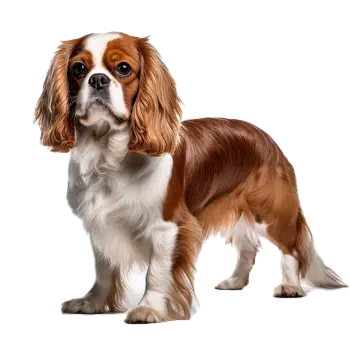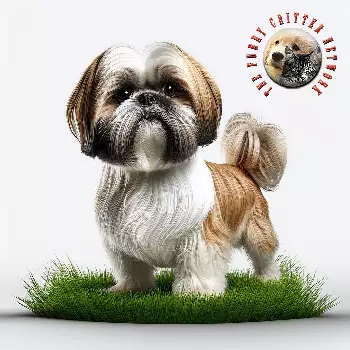Cava-Tzu
Hybrid Breed Description
The Cava-Tzu is a cross between the Cavalier King Charles and the Shih Tzu. Because each hybrid inherits a unique combination of traits from both parents, we recommend thoroughly researching both breeds before choosing a Cava-Tzu. Pay special attention to temperament, health issues, and care requirements, as your dog may express characteristics from either parent breed.
Cavalier King Charles

The Cavalier King Charles Spaniel is among the largest of the toy breeds, standing between twelve and thirteen inches at the withers and weighing thirteen to eighteen pounds. This breed displays a solidly built, slightly longer than tall frame with a compact body and moderately deep chest. The overall appearance combines regal sophistication with charming cuteness, presenting an elegant yet approachable demeanor. The breed features a distinctive face with large, round, dark brown eyes set well apart that contribute to its characteristic sweet and gentle expression. The skull is slightly rounded without excessive doming, and the muzzle is full and mildly tapered rather than flat. Long, feathered ears are set high and wide on the crown, fanning forward slightly to frame the face when the dog is alert. The neck is fairly long and gracefully arched, set atop well laid back shoulders. The Cavalier's silky coat is of moderate length with a slight wave permitted, though the texture should never be curly. Abundant feathering appears on the ears, chest, legs, and tail, with the long feathering on the feet being a distinctive breed characteristic. The coat comes in four recognized color patterns: Blenheim, which features rich chestnut markings on a pearly white ground; tricolor, displaying black and white with tan points over the eyes, cheeks, inside ears, legs, and underside of the tail; black and tan; and ruby, which is solid red. The Blenheim pattern often includes a valued lozenge mark or spot on the forehead. The breed's plumed tail is carried happily but never much above the level of the back, maintaining characteristic motion when the dog is active.
Key Characteristics
The Cavalier King Charles Spaniel demonstrates an enchantingly affectionate, playful, and intelligent personality, eagerly offering endearing devotion to its guardians. This breed is renowned for combining gentle attentiveness with a friendly, cheerful disposition that makes it an ideal companion dog. Shyness and aggression are notably absent from the breed's behavioral profile, replaced instead by an adaptable nature that thrives in various living situations. Cavaliers form strong attachments with their families and genuinely enjoy human interaction, making them pleasurable household companions who prefer not to be left alone for extended periods. Their desire to please combined with their social nature results in dogs that are typically friendly toward strangers and other pets, though they are not protective. The breed possesses moderate energy levels and demonstrates versatility in activity preferences. While they were bred as lap dogs and excel at providing comfort, Cavaliers retain spaniel heritage that gives them an enjoyment of moderate exercise and outdoor activities. They adapt well to both active families who engage in regular play and less active households that provide daily walks. Their intelligence and eagerness to please make them highly trainable and capable of excelling in obedience training, though positive reinforcement methods work best. The breed's playful nature persists throughout their lives, and they particularly enjoy interactive games and the opportunity to be the center of attention. Early socialization helps ensure well-rounded adults, though their naturally sociable temperament makes this process typically straightforward for owners.
The Cavalier King Charles Spaniel is unfortunately predisposed to several significant health conditions that potential owners should carefully consider. Mitral valve disease stands as the leading cause of death in the breed and is twenty times more prevalent in Cavaliers than in other breeds. This progressive heart condition affects over half of all Cavaliers by age five and nearly all by age ten. The disease involves degeneration of the mitral valve, causing blood to leak back into the left atrium and eventually leading to heart failure if untreated. Regular cardiac screening by a veterinarian beginning at age one is essential, as early detection allows for monitoring and management that can extend quality of life. Syringomyelia represents another serious neurological condition particularly affecting this breed, causing potentially severe pain due to fluid-filled cavities forming in the spinal cord near the brain. Additional health concerns include hip dysplasia, which causes improper fit of the thigh bone into the hip joint, and patellar luxation, where the kneecap dislocates from its normal position. Eye conditions such as cataracts, cherry eye, and dry eye require regular ophthalmologic examinations. The breed also shows predisposition to ear infections due to their long, heavy ears that require regular checking and cleaning. The average lifespan ranges from eleven to fifteen years. Responsible breeders screen for these conditions, and prospective owners should request health clearances for parents before acquiring a puppy. Regular veterinary care, maintaining appropriate weight, and monitoring for early signs of heart murmurs or other symptoms helps maximize the health and longevity of these beloved companions.
Shih Tzu

The Shih Tzu is a sturdy, compact toy breed standing between eight and eleven inches tall at the withers and weighing nine to sixteen pounds, with an ideal weight of ten to sixteen pounds. Despite their small stature, these dogs carry good weight and substance, presenting a body that is slightly longer than it is tall with a level topline and no tucked-up appearance. The head is notably round and broad with substantial width between the large, prominent dark brown eyes that create the breed's characteristic warm, sweet expression. The muzzle is quite short, measuring approximately equal in length to the skull and featuring a distinctly undershot bite that is required in the breed standard. The nose, lips, and eye rims are black on all coat colors, and the short snout gives the breed its brachycephalic appearance. The Shih Tzu's most striking feature is its luxurious, long, flowing double coat consisting of a silky outer layer and soft undercoat. This abundant coat can grow to floor length and comes in all color combinations, including white, black, gold, silver, blue, and various patterns of these colors. Many dogs display multiple colors with attractive markings, and white blazes on the forehead and white tail tips are particularly desirable in parti-colored dogs. The coat may have a slight wave but should never be curly, and proper texture prevents excessive matting. Large, heavily feathered ears set slightly below the crown of the skull blend into the neck hair. The tail is heavily plumed and carried gaily in a curve over the back, set high with its height approximately level with the skull. The breed's distinctive arrogant carriage with head held high combines with the flowing coat to create an elegant, regal appearance that has been treasured for centuries.
Key Characteristics
The Shih Tzu embodies a happy, lively, and affectionate temperament that makes it an outstanding companion dog. Originally bred as a lap dog for Chinese royalty, the breed's primary purpose has always been providing delightful company, and this heritage remains evident in their behavior today. Shih Tzus are remarkably friendly and typically get along well with children, other pets, and strangers, displaying confidence without aggression. They thrive on human companionship and genuinely enjoy being the center of attention, making them pleasurable household pets who tend to require substantial personal interaction each day. Their social nature means they can develop separation anxiety if left alone for extended periods, and they perform best in homes where someone is present during the day. Despite their small size and lap dog heritage, Shih Tzus are intelligent dogs capable of learning commands and tricks, though they can display a stubborn streak during training. Their clever nature and desire to please respond well to positive reinforcement methods, patience, and consistency, though they may be somewhat challenging to housetrain. The breed demonstrates moderate energy levels with brief bursts of playful activity between longer stretches of calm behavior. They enjoy short daily walks and interactive play sessions but are equally content to curl up on the couch with their families. While alert enough to announce visitors, Shih Tzus are not protective and would likely welcome intruders with friendly greetings rather than guarding behavior. Early socialization helps them develop into well-adjusted adults who adapt comfortably to various living situations including apartments. Their adaptable, gentle, and loving nature combined with minimal exercise requirements makes them ideal for many types of households.
The Shih Tzu is generally a healthy breed with a lifespan ranging from twelve to sixteen years, though like all brachycephalic breeds, they are predisposed to certain health conditions related to their facial structure and other genetic factors. Their shortened muzzle and flat face create breathing difficulties, particularly in hot or humid weather, making them susceptible to heat stroke and requiring careful monitoring during physical activity and warm conditions. The prominent eyes characteristic of the breed are vulnerable to various problems including corneal ulcers, dry eye syndrome, progressive retinal atrophy, and cataracts. Regular ophthalmologic examinations help detect these conditions early. Their drop ears with abundant hair growth inside the ear canal predispose them to frequent ear infections, necessitating regular cleaning and monitoring. Orthopedic issues commonly affect Shih Tzus, including patellar luxation where the kneecap dislocates from its normal groove, hip dysplasia causing improper joint formation, and intervertebral disc disease that can lead to back problems and potential paralysis. Maintaining appropriate body weight helps reduce stress on joints and the spine. Dental problems occur frequently in the breed due to their small mouths and crowded teeth, requiring diligent home care with daily tooth brushing and regular professional cleanings beginning at an early age. Additional health concerns include portosystemic shunt affecting liver blood flow, kidney disease, bladder stones, and umbilical hernias. Some Shih Tzus develop allergies causing skin irritation and requiring dietary management or medication. Regular veterinary examinations, preventive care, proper nutrition, and attention to grooming needs help ensure these companion dogs enjoy their full lifespan as healthy, happy family members.
Important to Remember
Each hybrid dog is unique and may inherit any combination of traits from either parent breed. The information above represents the characteristics of the purebred parent breeds. Your Cava-Tzu may favor one parent over the other or display a blend of both. We strongly encourage you to read the complete breed profiles for both the Cavalier King Charles and Shih Tzu to fully understand the range of possible temperaments, health concerns, and care requirements.